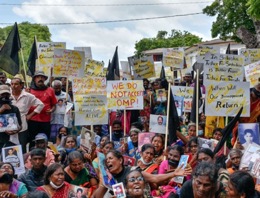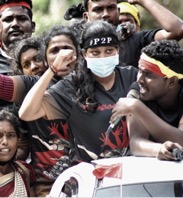The women left behind. Long-term effects of enforced disappearances on Tamil women in Sri Lanka
This is the fifth blog in a series written by LLM students on the Human (In)Security course at Edinburgh Law School. This series celebrates the top five blogs selected in a class competition. This blog is by Caroline Walka. Caroline is currently reading the LLM in International Law at the University of Edinburgh. She is from Germany, where she studied law at the Freie Universität.
The women left behind: Long-term effects of enforced disappearances on Tamil women in Sri Lanka
People around the world celebrate Valentine’s Day on the 14th of February – for the Tamil population of Sri Lanka, the 14thof February has a different name and meaning. On “Missing Lovers Day”, they instead celebrate their loved ones who forcibly disappeared during the civil war or its aftermath, and whose fates remain unknown today.
Background
The civil war in Sri Lanka occurred from 1983 until 2009 between the Sinhalese dominated government and the Liberation Tigers of Tamil Eelam (LTTE). The LTTE fought for an independent state for the supressed Tamil minority in Sri Lanka. After almost 30 years of fighting with only a few periods of cease-fire, the UN estimates the conflict caused around 100.000 casualties, with around 40.000 Tamils killed in the final months of the war alone[1]. The fighting was characterised by human rights violations and potential war crimes on both sides, including unlawful killings, torture and the recruitment of child soldiers.[2] However, one violation has affected and still affects more people than any other: The former Sri Lankan government has acknowledged that about 65.000 people have been victims of enforced disappearances from the eighties until today. Amnesty International even estimates it is up to 100.000 people.[3] While some of these were participants in a Marxist uprising in the late eighties, most of the victims are Tamils that were suspected of connection to the LTTE.[4]The majority remain missing or have been declared dead.
Enforced disappearances and human rights
Enforced disappearances are “the governmental practice of eliminating political dissidents while denying any responsibility or knowledge thereof”[5]. Statistically, between 70% and 94% of victims are male. The rights of these men to liberty and security (Art. 9 ICCPR), fair trial (Art. 14 ICCPR), and more, are often violated as a short-term effect.[6]
However, research in recent years has shown that it is the women left behind who are suffering the long-term consequences, on-going violations of their human rights long after their husbands disappear.
Tamil men are traditionally assigned the role of the breadwinner, while women take care of the household and children. Consequently, when a Tamil man forcibly disappears, the woman has no choice but to take over and make money, although that is frowned upon by society. For many women, this also means a descent into poverty.
Often the family’s assets – the house, bank accounts etc. – are listed under the man’s name. In order to gain access to these and potential claims to a pension, wives have to let their husband be declared dead, even though they might face backlash for “giving up” on their spouse.
In addition to that, the constant stress caused by the uncertainty about the fate of their loved one can lead these women to suffer PTSD, depression and other mental health issues.
Finally, women living without a man are statistically more often exposed to violence, especially sexual violence. In order to protect themselves and return to a more stable position, the women can remarry. However, this is frowned upon in Tamil society. Therefore, a lot of women try to avoid a second marriage and instead live with their missing husband’s family. There they might be seen as a “financial burden” and be treated unequally to the rest of the household.
When they are looking for their spouse, women often face harassment or aren’t taken seriously by authorities.
All these consequences lead to a grave deterioration of the women’s rights, including but not limited to the right to a standard of living, the right to health (Art. 11, 12 ICESCR) which in many cases still impact their lives today.[7]
Women fighting for their rights
As desperate some of their situations are, Tamil women have been fighting the violation of their rights as well as of their missing relatives’ relentlessly. With the help of the UN and NGOs, they continue to protest, seek answers and demand reparations. Both of these parties play an important role as supporters, as the UN has the means to address the issue from the top, working with or exerting pressure on the government, while NGOs can work their way up from the bottom, addressing individual cases and fighting for awareness.
The UN has taken several different steps to get an overview of the situation in Sri Lanka and to guide the government in restoring human rights protections, including those of the family members of the forcibly disappeared. The UN Human Rights Council (HRC) has gathered information through Universal Periodic Reviews, the UN Office of the High Commissioner for Human Rights and Special Rapporteurs. Based on these reports, the HRC has issued several resolutions, the most important being 30/1 (2015). Therein, the HRC emphasizes the importance of the transitional justice framework of justice, truth-seeking and reparations of the families of the forcibly disappeared. It welcomes the establishment of a Missing Persons Office by the Sri Lankan government and its willingness to cooperate with the HRC to resolve the ongoing issue.
Amnesty International, Human Rights Watch and other NGOs have tried to draw up lists with names of the disappeared to support the women in their search. These lists have been sent to the Sri Lankan government with an urgent appeal to provide the families of the victims with information regarding their whereabouts.
However, since the election of President Gotabaya Rajapaksa in October 2019, the process of restoring the victims’ human rights has come to a halt. Rajapaksa, who was Defence Minister during his brother’s presidency and the last years of the war, has withdrawn Sri Lanka’s support of HRC resolution 30/1. Instead,reports on new enforced disappearances and threats made towards those searching for their missing relatives and human rights activists are becoming more and more regular.
But however great the adversity they’re facing, Tamil women are not giving up. Starting on the 03rd of February, many took part in a march from the South to the North of Sri Lanka, again protesting for the restoration of their human rights and those of their missing loved ones.
[1] Report of the Secretary-General’s Panel of Experts on Accountability in Sri Lanka, 31 March 2011, https://www.securitycouncilreport.org/atf/cf/%7B65BFCF9B-6D27-4E9C-8CD3-CF6E4FF96FF9%7D/POC%20Rep%20on%20Account%20in%20Sri%20Lanka.pdf, p. 41.
[2] Ibid., ps. 9 et seqq.
[3] ““Only Justice Can Heal Our Wounds” – Listening To The Demands Of Families Of The Disappeared In Sri Lanka”, Amnesty International, https://www.refworld.org/pdfid/58e200c04.pdf, p. 7.
[4] Ibid.
[5] Grossmann, C. M., “Disappearances”, Max Planck Encyclopaedias of Public International Law.
[6] Vitkauskaite-Meurice, D., Zilinskas J., “The Concept of Enforced Disappearances in International Law”, Jurisprudencija Vol. No. 2 (2010), 197, 198.
[7] An overview over the consequences for women: ““Only Justice Can Heal Our Wounds” – Listening To The Demands Of Families Of The Disappeared In Sri Lanka”, Amnesty International, https://www.refworld.org/pdfid/58e200c04.pdf, ps. 15 et seq.; Dewhirst, P., Kapur A., “The Disappeared and Invisible – Revealing the Enduring Impact of Enforced Disappearance on Women”, International Center for Transitional Justice (2015), ps. 6 et seqq.


